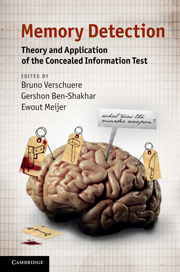Book contents
- Frontmatter
- Contents
- List of figures
- List of tables
- Notes on contributors
- Acknowledgments
- Part I Introduction
- Part II The laboratory: theoretical and empirical foundations of the Concealed Information Test
- Part III Field applications of concealed information detection: promises and perils
- 8 Limitations of the Concealed Information Test in criminal cases
- 9 Validity of the Concealed Information Test in realistic contexts
- 10 Leakage of information to innocent suspects
- 11 Countermeasures
- 12 Psychopathy and the detection of concealed information
- 13 Clinical applications of the Concealed Information Test
- 14 Daily application of the Concealed Information Test: Japan
- 15 The Concealed Information Test in the courtroom: legal aspects
- Part IV Conclusions
- Index
- References
12 - Psychopathy and the detection of concealed information
Published online by Cambridge University Press: 05 June 2012
- Frontmatter
- Contents
- List of figures
- List of tables
- Notes on contributors
- Acknowledgments
- Part I Introduction
- Part II The laboratory: theoretical and empirical foundations of the Concealed Information Test
- Part III Field applications of concealed information detection: promises and perils
- 8 Limitations of the Concealed Information Test in criminal cases
- 9 Validity of the Concealed Information Test in realistic contexts
- 10 Leakage of information to innocent suspects
- 11 Countermeasures
- 12 Psychopathy and the detection of concealed information
- 13 Clinical applications of the Concealed Information Test
- 14 Daily application of the Concealed Information Test: Japan
- 15 The Concealed Information Test in the courtroom: legal aspects
- Part IV Conclusions
- Index
- References
Summary
Overview: The most common application of concealed information detection is crime knowledge assessment in crime suspects. The validity of this application has mainly been investigated in healthy subjects. Criminals may differ in important aspects from healthy subjects. Psychopathy, for example, is quite common among criminal populations. Psychopathy is characterized by affective–interpersonal (e.g., shallow affect) and behavioral–lifestyle (e.g., impulsivity) features. The latter is associated with physiological hyporesponsivity, and could threaten the validity of concealed information detection. I will review empirical research that has examined this possibility. Directions for future research will be discussed.
The most common application of concealed information detection is to assess whether a crime suspect has intimate knowledge about the crime under investigation. A concern with this application is that – particularly under real-life circumstances (Elaad et al., 1992) – guilty suspects may escape detection. Several factors might explain this modest sensitivity. Guilty suspects may not remember certain crime details. Another, less investigated, source of error is individual differences in responsivity. Despite perfect recognition, some individuals do not respond to concealed information. From the very beginning, this was recognized by David Lykken, who stated that college students are “hardly representative of the average run of criminal suspects” and that “perhaps a proportion of the latter would not respond ‘normally’ in such a test” (p. 387; Lykken, 1959). Lykken did not specify who these non-normal responding individuals might be. We now know that mental disorders are very common in the prison population.
- Type
- Chapter
- Information
- Memory DetectionTheory and Application of the Concealed Information Test, pp. 215 - 230Publisher: Cambridge University PressPrint publication year: 2011



